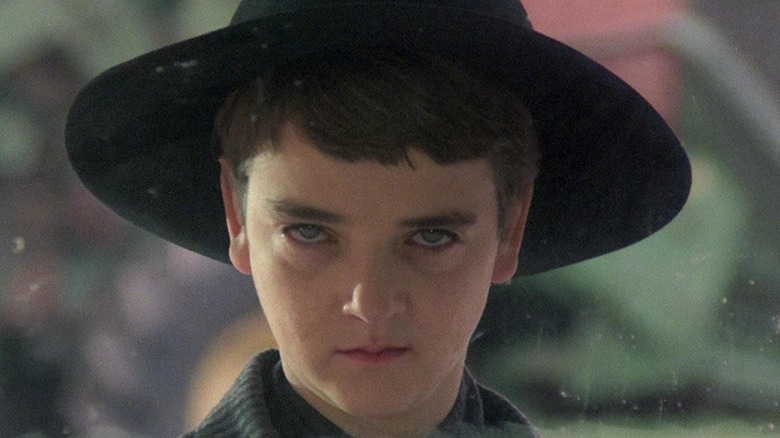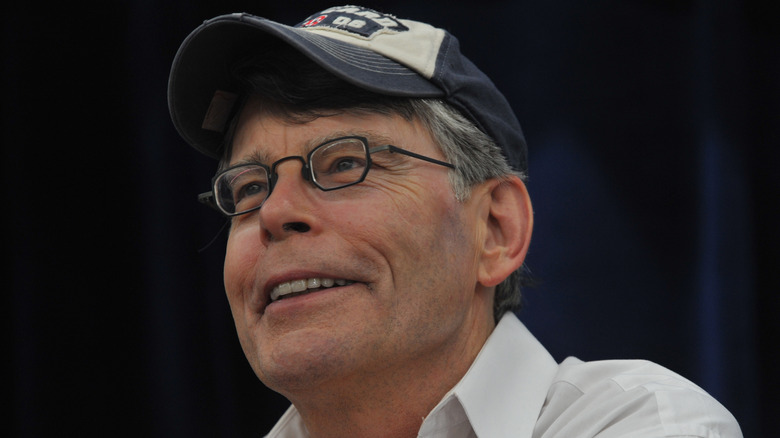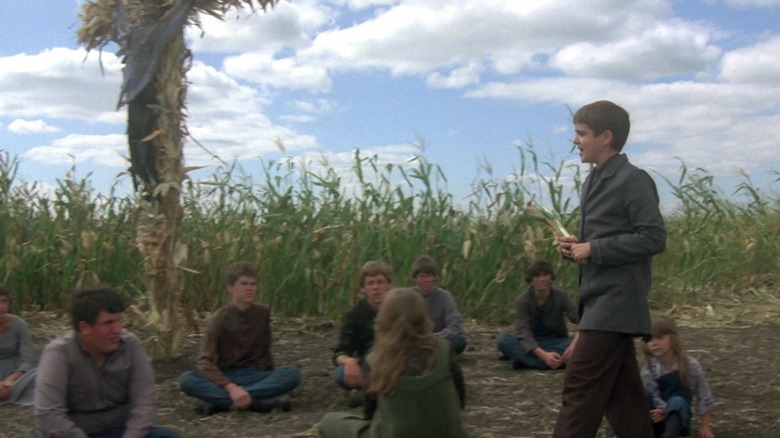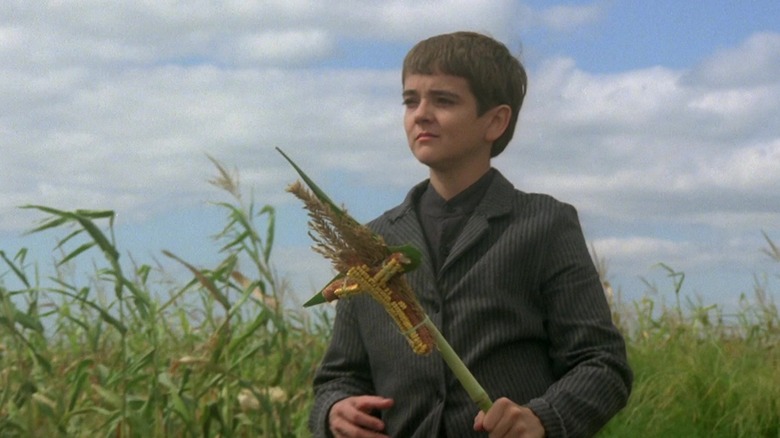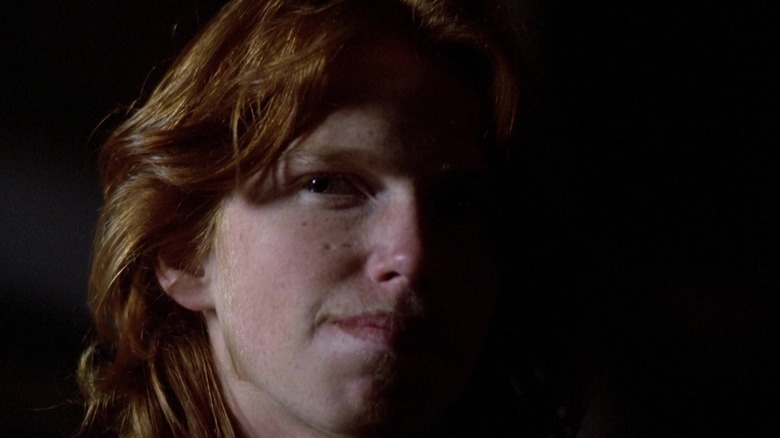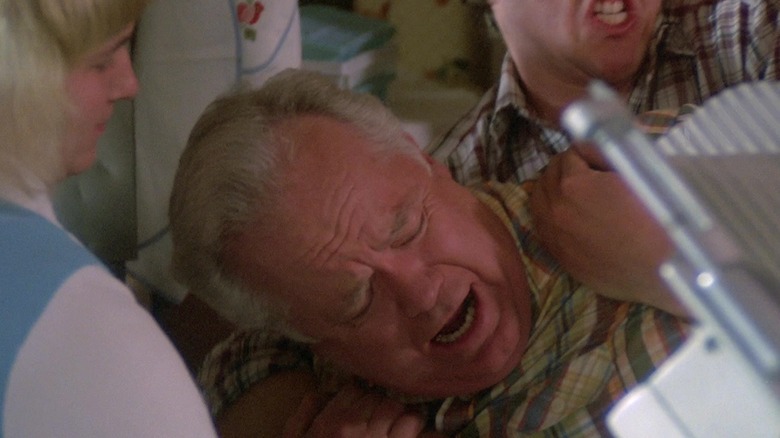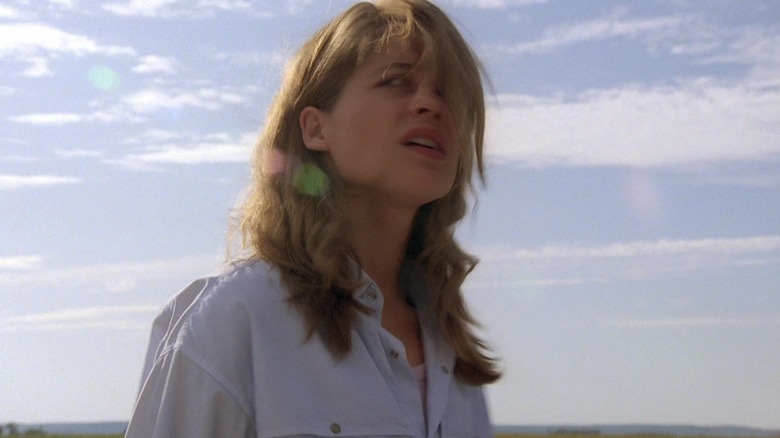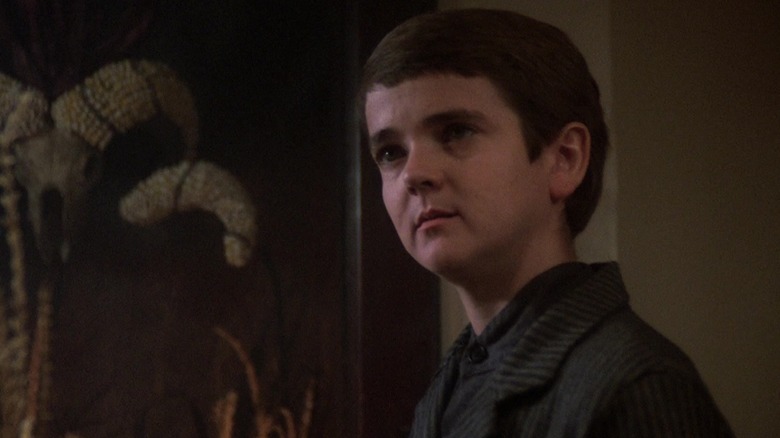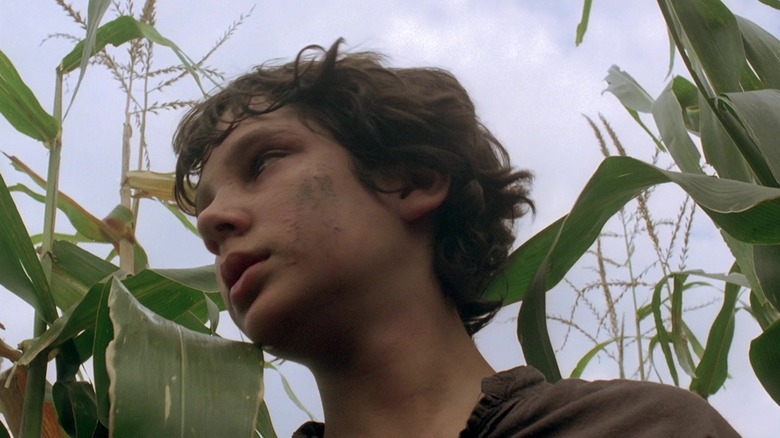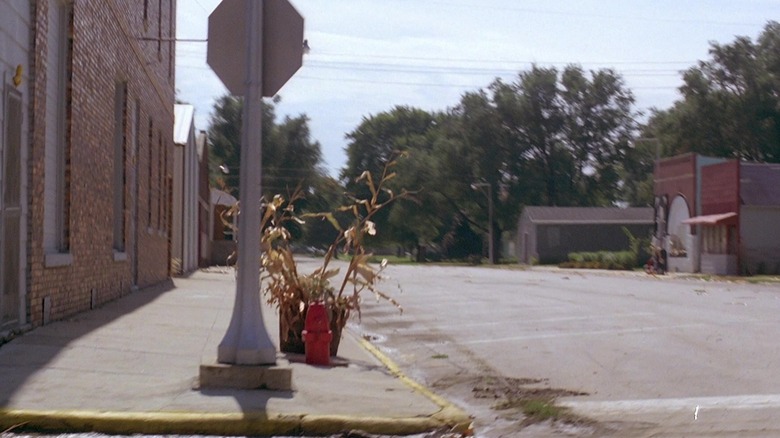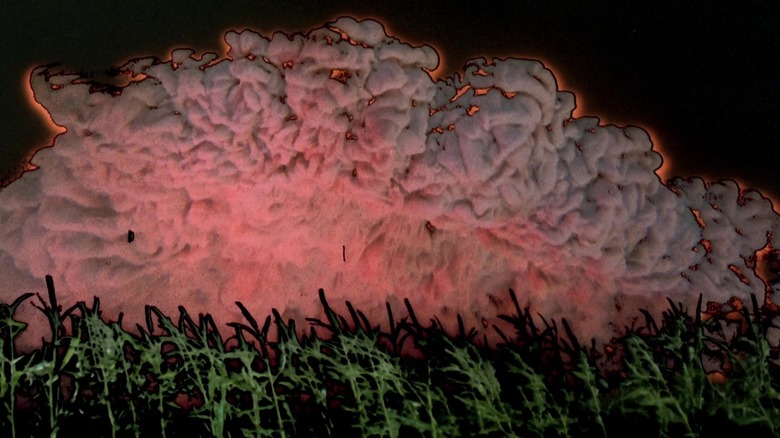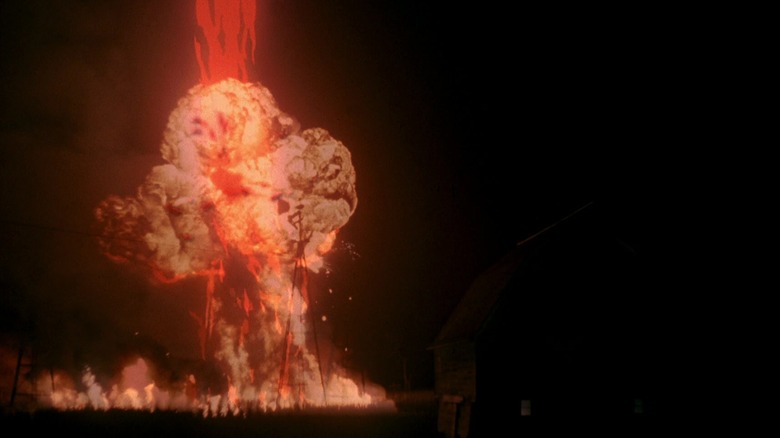Creepy Facts About Children Of The Corn Only Huge Fans Know
When "Children of the Corn" premiered in 1984, it didn't look like it would have any sort of staying power. Sure, the film recouped its tiny budget, but it was critically panned and summarily dismissed. That is, until it accrued a cult audience intrigued by its mythology, thrilled by its scares, and eager for more.
Watching the film today, you'll certainly encounter "corny" dialogue, budget special effects, and amateurish acting. But the move also has a pervasive creepiness, found largely in the compelling performance of John Franklin; coupled with the dissonance of children performing evil acts, and the strange entity known only as "He Who Walks Behind the Rows," it's hard to deny that the movie has an out-there charm.
Adapted from a Stephen King short story, "Children of the Corn” follows Burt (Peter Horton) and Vicky (Linda Hamilton), a couple who get stranded in a small town in Nebraska after they hit a child who steps out in front of their car. While trying to find help, they are captured by a cult of children, led by Isaac (John Franklin) and Malachai (Courtney Gains), who kill adults as a sacrifice to "He Who Walks Behind the Rows."
Whether you're a diehard fan or a newbie, you might be surprised by these untold truths of "Children of the Corn."
Stephen King wrote a version of the screenplay, but it was rejected
Stephen King's short story "Children of the Corn" was first published in an issue of Penthouse magazine in 1977, and then re-released in "Night Shift," his first collection of short stories. By the time Hal Roach Studios purchased the rights to the story, King adaptations were becoming increasingly popular and successful, with films like "Carrie" and "The Dead Zone" having already achieved success.
As King was such a prominent figure, the studio offered to let him write a screenplay adaptation of his short story. However, the studio didn't like the end result. Instead, they hired screenwriter George Goldsmith to write a new draft. King and Goldsmith weren't on great terms throughout that process. Goldsmith recalls getting on a conference call with the author. "Stephen opened up by informing me I did not understand horror and I countered that he did not understand cinema," he said in a 2022 interview. "Horror and fiction are internalized, just like his script. Cinema is external."
It's spawned more sequels than any other Stephen King property
While "Children of the Corn" was profitable, it wasn't the runaway success other Stephen King films had been at the time. Even now, existing as a cult classic, it still doesn't get as much love as you'd expect, with a mere 39% on Rotten Tomatoes.
Nevertheless, "Corn" has inspired more sequels and remakes than any other King story. Following in the wake of the original, there has been a whopping eight sequels. Not only that, but there have been two remakes of the first story — one a TV movie released in 2009, the other a 2020 film distributed by Freestyle Releasing. But King isn't particularly thrilled with the many direct-to-video bastardizations of his short story.
"'Children of the Corn' has generated more awful sequels than any other story in my oeuvre," he said in 2022. "If my internet connection weren't down as I write this I'd check and see if there wasn't even a Children of the Corn in Space. I almost think there was. The only one I was really rooting for was Children of the Corn Meet Leprechaun. I wanted to hear that little leprechaun guy shouting, 'Give me back me corn!' in his cute little Irish accent."
In 2017, Stephen King took back the rights to many of his properties, including "Children of the Corn," prohibiting future U.S. adaptations without his blessing.
John Franklin was 23 during the shoot, though he plays a 12 year old
The titular children in "Children of the Corn" are in a religious cult, led by the powerful young boy Isaac. Franklin played this child tyrant, though he was actually a 23-year-old young adult at the time. The actor has a condition known as Growth Hormone Deficiency, which stunted his height and made him very young-looking. As an adult, he stood at "barely five feet" tall. "He had a quality of delivery that made you very nervous," recalled director Fritz Kiersh in the making-of featurette "Harvesting Horror: The Making of Children of the Corn."
The role was one of Franklin's first ever roles in Hollywood, and he was incredibly nervous.
"I was a green kid at the time," he recalls in Harvesting Horror, "just trying to get through the day, with remembering my lines and not tripping on the furniture." Since his character is a religious leader, he had many long speeches to perform, and so he spent the weeks prior to the shoot memorizing lines. When it came to actually shooting one of the speeches, Franklin performed it perfectly, and the crew were so impressed they started to call him "One Take Kid." "Then the pressure was on," Franklin said. "It was very stressful."
Courtney Gaines pulled a crazy stunt during his audition
In "Children of the Corn," cult leader Isaac's right-hand man is the older, intimidating Malachai, played by Courtney Gaines. While Isaac keeps the group of children in line mentally and philosophically, Malachai keeps them in line physically — and his bright red hair and prominent underbite are extremely memorable.
It turns out that the underbite — and Malachai's physically intimidating presence in general — was carefully crafted by Gaines, beginning during his audition.
During his "Corn" audition, Gaines was asked to act out a scene where he was taking someone hostage. Gaines, a self-described Method actor, brought a stage knife to his audition, putting it to his scene partner's neck. His scene partner may not have been very happy, but it made an impression on director Fritz Kiersch.
"Courtney Gaines came to our casting session disheveled, long red hair, mean, in a vibe, ready to rip the room apart," Kiersch recalls in "Harvesting Horror." By the end of the audition, we knew that we'd cast the young man."
For Gaines' part, he recognizes that it maybe wasn't the best move. "I ended up pulling a fake knife on the person I was reading with, Jeff Goldberg, who went on to be a big casting director himself," Gaines told HVY Journalists. "He tells people this story as what not to do in a casting session, and he is right, but I guess I left an impression."
And that underbite? At the time, Gaines actually had "buck teeth," he says in "Harvesting Horror," but he forced an underbite to further distort his face and look even meaner.
The director was careful not to show violence on screen
While the budget for "Children of the Corn" was around $1.3 million, a huge chunk of that money went to paying King for the story's rights and his work on the first draft of the screenplay. That left director Fritz Kiersch with around $800,000, a small budget for a feature film (as explored in "Harvesting Horror"). Kiersch was excited to make a horror flick with a b-movie aesthetic, but at the same time he didn't want to sacrifice in terms of the horror.
Kiersch decided to take his cues from the master of suspense: Alfred Hitchcock. "I wanted to do what Hitchcock was very famous in doing, which was to show two events, and in editing create an end result in the viewer's mind," Kiersch says in "Harvesting Horror." "Show the knife, show the blood, but never show the penetration of the knife."
Actor Courtney Gains remembers how this played out in one of the film's most terrifying scenes: the massacre of the town's remaining adults in a diner. Gaines' character, Malachai, cuts off a man's hand using a deli slicer. "What they show is the blood on the face, and his reactions," he recalls in the making-of featurette "Harvesting Horror." "[Kiersch] wanted the movie to be suspenseful, but he wanted the audience to use their imagination more than actually see the killings," actor Jonas Seaman told fan site ChildrenoftheCornMovie.com.
Kiersch felt like this approach would make their limited budget stretch farther, because the viewers' imaginations would be more effective than any low-rent special effects. "That which you did not see became more frightening than that which you would see," he explains in the featurette.
In one iconic scene, Linda Hamilton was just as scared as the audience
The impetus for the events in "Children of the Corn" is a car accident. Burt (played by Peter Horton) and Vicky (played by Linda Hamilton) are a young couple driving across the country. While they're distracted looking at a road map, they don't notice that a child has stepped out into the road, in the path of the car. They hit the child, and then discover that he has died. Burt goes out into the corn fields to find help, leaving Vicky behind in the car. Vicky, upset, goes over to the child (who has been covered with a blanket) to mourn.
For this moment, director Fritz Kiersch played a trick on Linda Hamilton.
"Linda, I'm sorry, you're going to have to work with this mannequin, we couldn't have a child out there, it's too hot," Kiersch remembers saying at the time (via "Harvesting Horror"). That was a lie; they did indeed have the child actor under the blanket. When Hamilton goes over to the child, and he suddenly sits up, the reaction you see is real. "
We scared the crap out of her," said Jonas Seaman. Added Kiersch: "To me, that's the best scare in the movie."
Another horror film gets its inspiration from the crew of the USS Enterprise
John Franklin has some advantages coming into the role of Isaac. He was an adult, even though he looked like a child, which made it easy for him to portray his young character as uncomfortably mature. He had also just finished a run in the play "The Innocents" in Chicago, where he played a young boy who is possessed, so he had some of the horror elements down. As a big fan of Stephen King, Franklin wanted to make sure he got everything right. So, although there isn't much detail about Isaac in the short story, Franklin put his all into developing the character.
"[I] did research where I'd watch these boy preachers on late night TV," he recalled in "Harvesting Horror." "And then I went to a couple actual churches too. I wanted to see preachers in action, more flamboyant. So I just saw the control that they had. It was just complete."
There was one more key element in creating the Isaac character: the hair. Franklin had done a commercial right before the "Children of the Corn" shoot in which he played a Star Trek Vulcan. For the commercial, he got that oddly bowl-like Vulcan haircut typically seen on Leonard Nimoy's Spock. When he arrived on set for "Children of the Corn," the production team asked him to keep it, declaring the off-putting look perfect for the role. Much like "Halloween," another horror classic had taken its inspiration from ... of all places ... Star Trek.
The corn itself was central to the design of the film
Once the production team had a script, the next step was to figure out where they would shoot the film. For this, there was one major requirement: corn. Lots and lots of corn.
"One of the concepts I had in the film was that these people entered an island ... this little town surrounded by corn. So they were marooned," director Fritz Kiersch says in "Harvesting Horror: The Making of Children of the Corn." For the shoot, the crew was based in Sioux City, Iowa, but drove miles out of town each day so that they'd be surrounded by fields of corn. "You're really surrounded by this environment where there's nothing," Kiersch said. "It's eerie."
However, just being surrounded by corn wasn't enough. In the making-of featurette, Kiersch shared that art director Craig Stearns and set decorator Cricket Rowland filled every frame with corn. In every corner of the abandoned town, there are corn stalks.
But all that corn did come with some problems. In "Harvesting Horror," actor Courtney Gaines remembers that as the shoot went on, and the summer waned, the cornstalks went from green to yellow, because they were drying out. The art team spray painted the corn to try and maintain the film's continuity. "They were always pulling their hair out because of the corn," Gaines recalled.
The cast and crew loved working with the locals
"Children of the Corn" was shot in rural Iowa, with the production setting its home base in Sioux City.
"It was quite surreal. I mean, Sioux City, Iowa is already quite strange," actress Julie Maddalena remembered in 2016. "And that poor little town really didn't know what they were getting into." Nevertheless, the filmmakers were very much welcomed.
"The people in that part of the country were terrific. They embraced the whole opportunity," Kiersch has recalled of the experience. In Sioux City and neighboring towns, locals were eager to accommodate the production, from closing streets to locals appearing as extras in the film. The townspeople even brought people into their home.
"I'd go have dinner at people's houses and meet their families," Gaines recalled in "Harvesting Horror." " I'm a city kid, so going to this really small, rural town was actually really refreshing to me." Adds Franklin: "It was such a warm, incredible experience."
He Who Walks Behind the Rows was created through budget special effects
For the climactic show-down with "He Who Walks Behind the Rows," director Kiersch had to get creative. "The script leaves the monster very unclear. It's not well-defined," he said in "Harvesting Horror: The Making of Children of the Corn." "So, my feeling was the monster is everything around us when we are isolated and alone."
In the film, the monster is never actually seen. Rather, its presence is shown through how it affects the environment. "The noises, the ground, the wind. Those are the things that scare you," said Kiersch. With its limited budget, the production didn't have many special effects at its disposal. Kiersch knew he wanted it to look like there were tentacles or something moving beneath the ground. To achieve this, the crew dug a ditch in the cornfields, outfitted it with a wooden track, and then fitted an upside-down wheelbarrow to the track. They covered the wheelbarrow and the ditch with a piece of canvas, and covered that with loose soil. When they then moved the wheelbarrow, it shook the canvas and soil, making it appear as though the ground was moving.
Other shots were achieved by strapping the camera to a tractor; the intimidated clouds that blustered up were made from repurposed test footage, which Kiersch got from a friend.
The climactic explosion was a major event for the local community
At the end of the film, "He Who Walks Behind the Rows" finally meets his demise in an enormous explosion. For Sioux City and the other small towns the production filmed in, the day of this explosion was a major event.
"We had a peanut gallery from all the different cities in the neighborhood," Kiersch recalled in "Harvesting Horror," saying the audience had pickup trucks, lawn chairs, and picnic blankets. Adds Corey Frizzell, one of the film's featured child actors: "For the Siouxlanders, there was a lot of excitement."
Frizzell recalls a lot of hubbub in the area leading up to the big event. "The night of the explosion they had several wind machines, some fire trucks," he recalls, "and a lot of crew scrambling around of this scene."
The explosion took most of the day to set up, and multiple cameras were on standby, as they only had the opportunity for one take. It turned out well; Kiersch remembers that the explosion resulted in a "ten-story fireball."
"I don't think anyone was disappointed," Gaines says. "It was a pretty cool mushroom effect explosion."
Corey Frizzell, however, ended up missing the excitement. As he would recall years later, his mom had a lengthy conversation with Linda Hamilton as they were all waiting for the explosion, and he fell asleep in his mother's lap.
